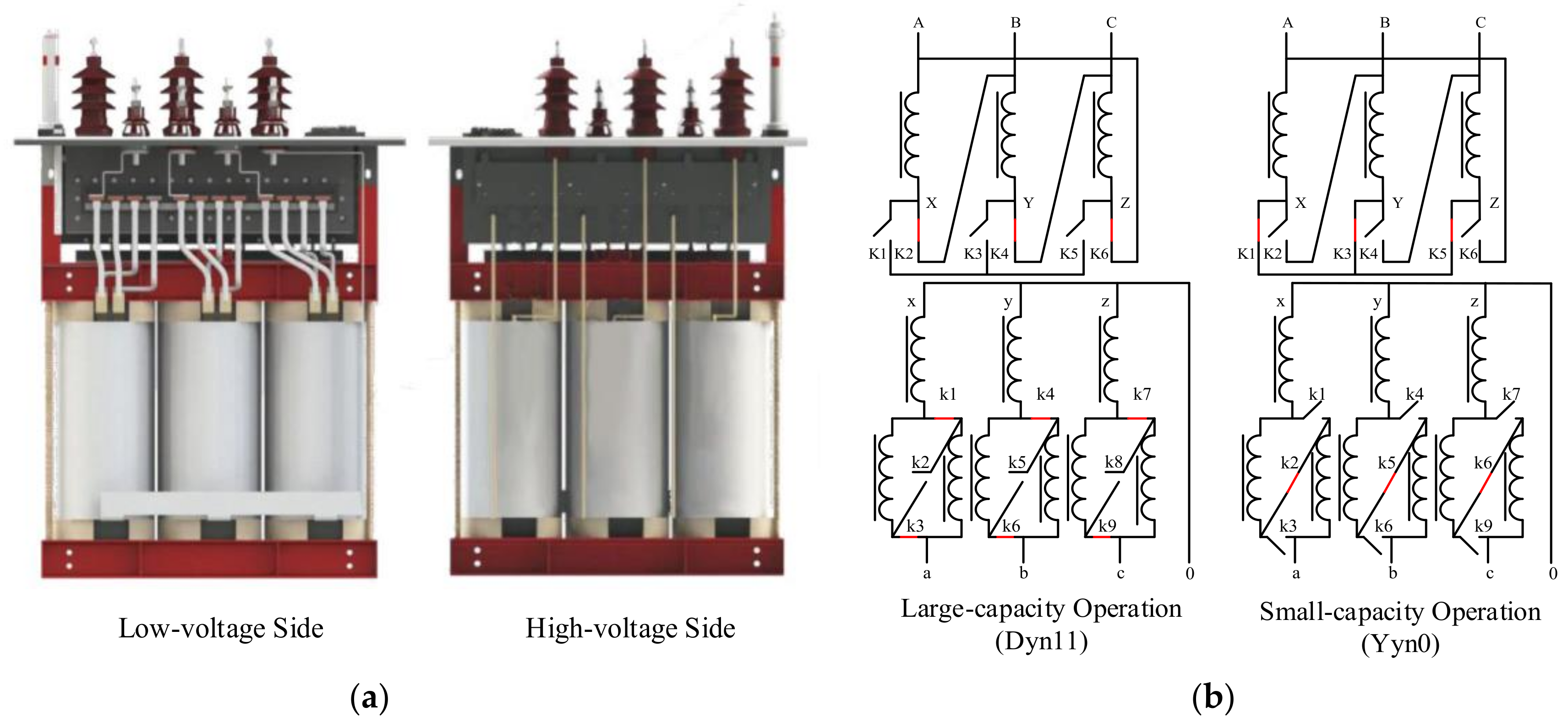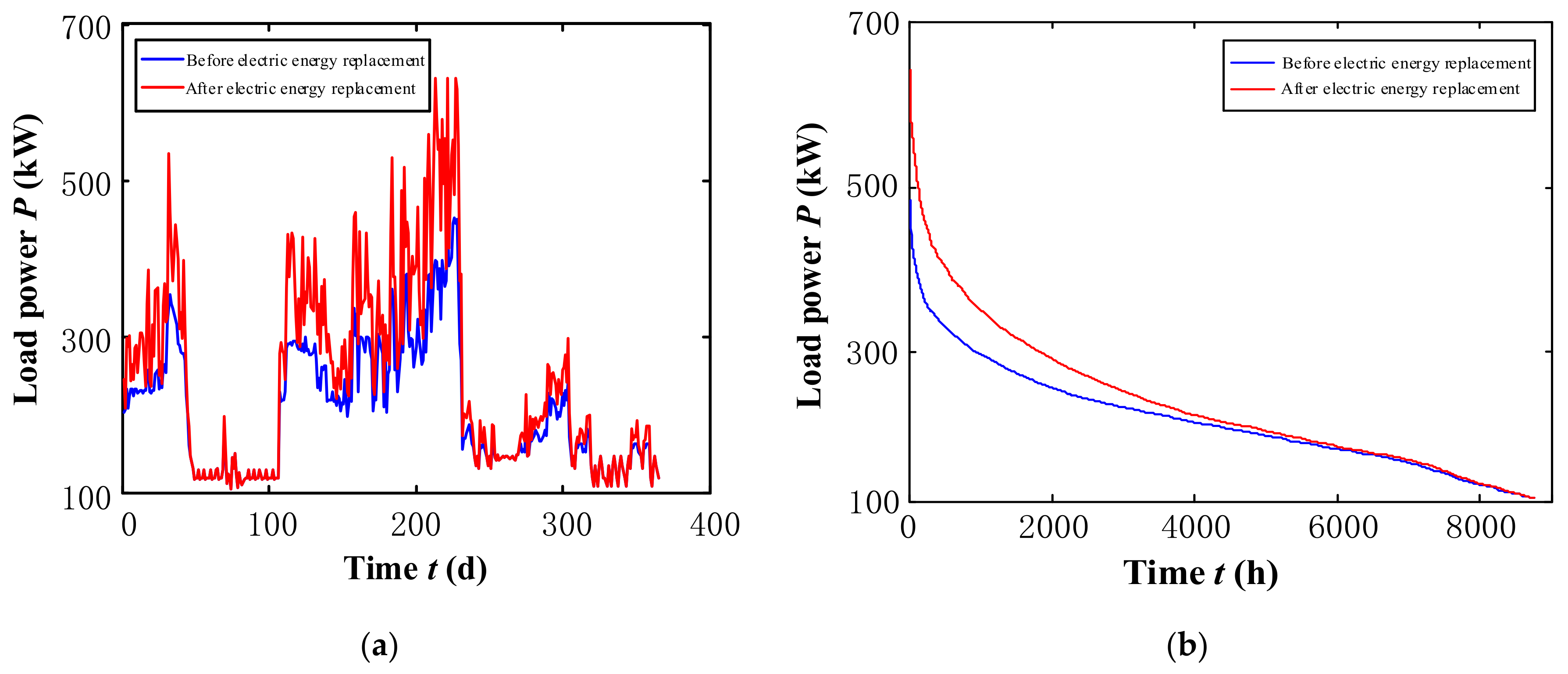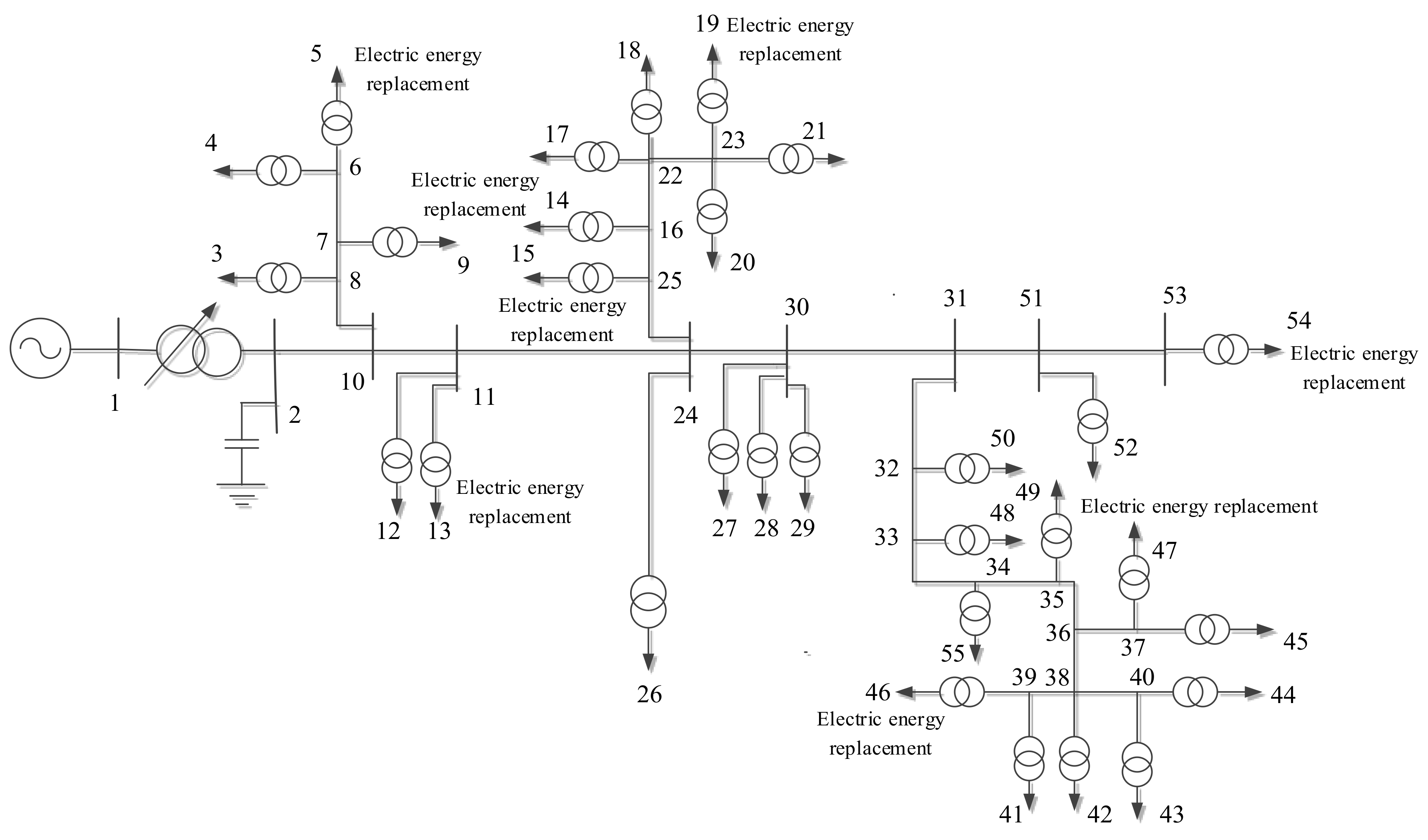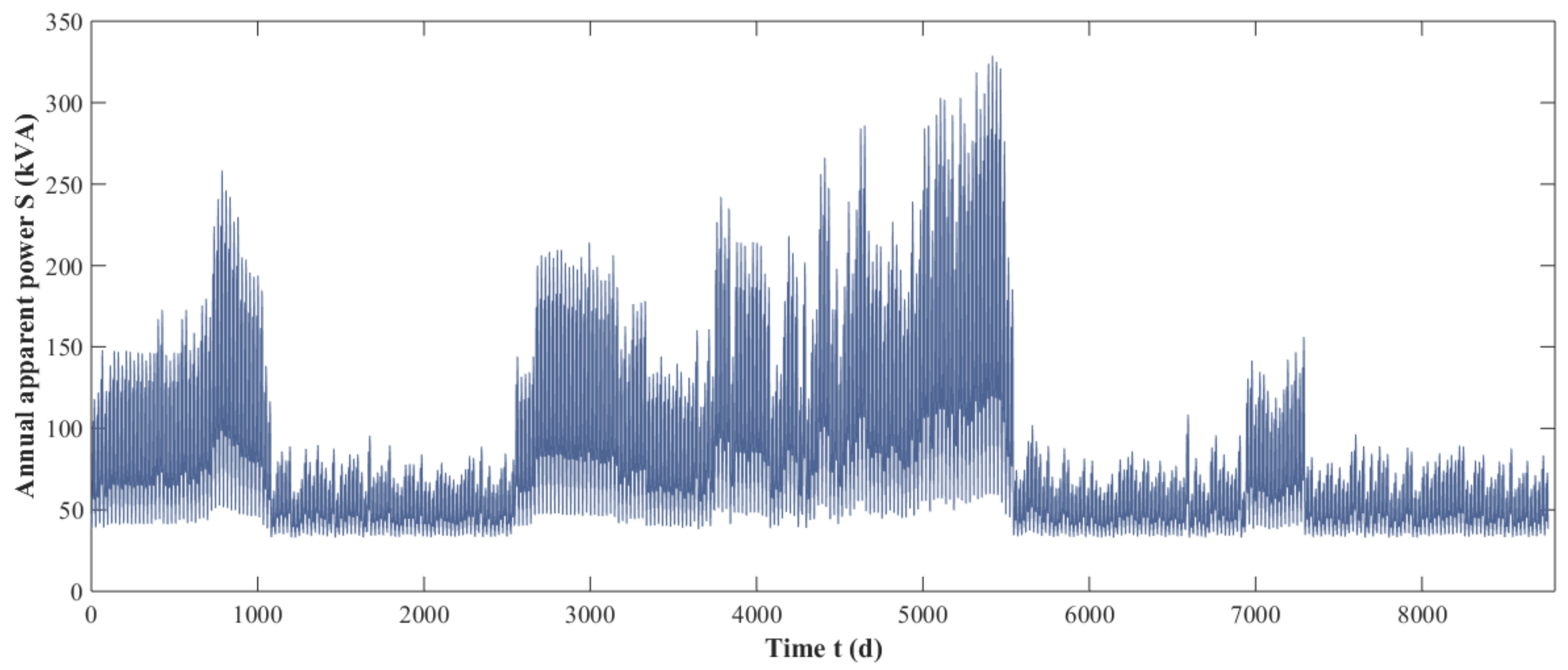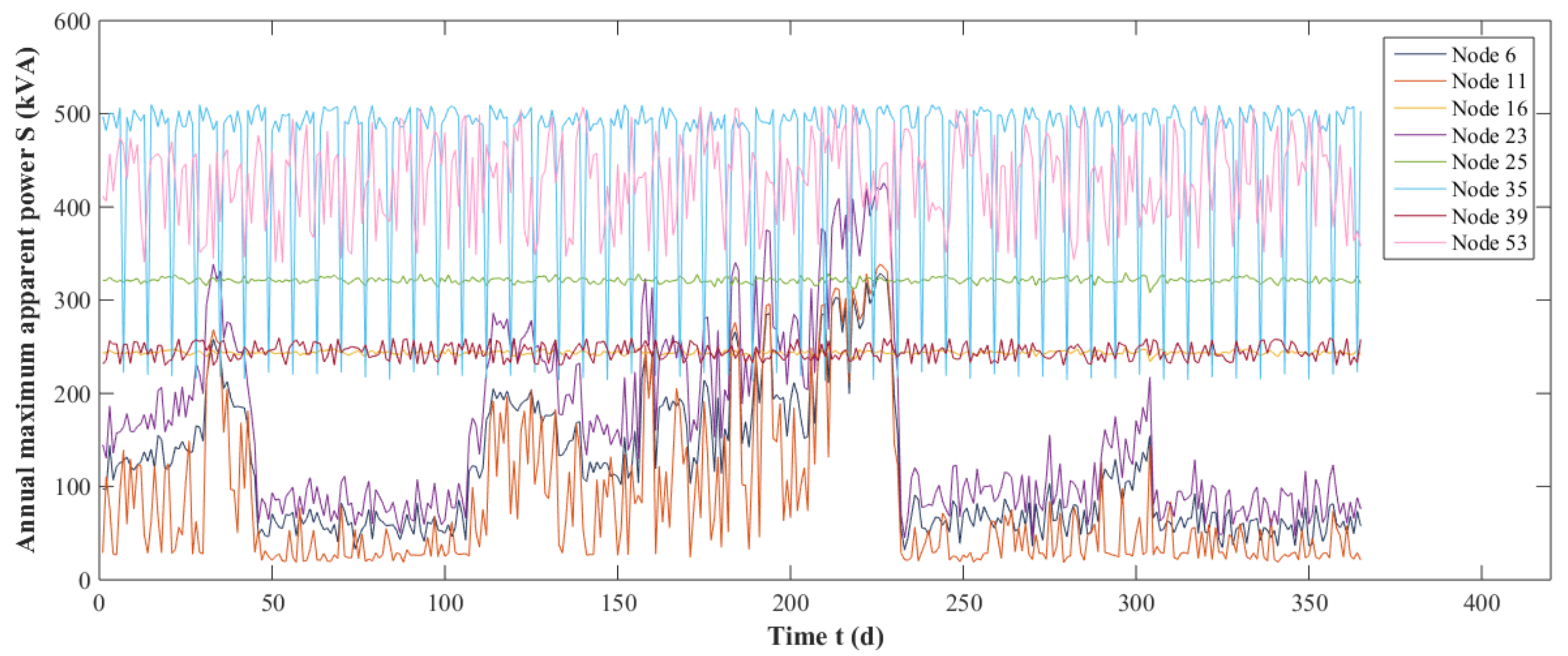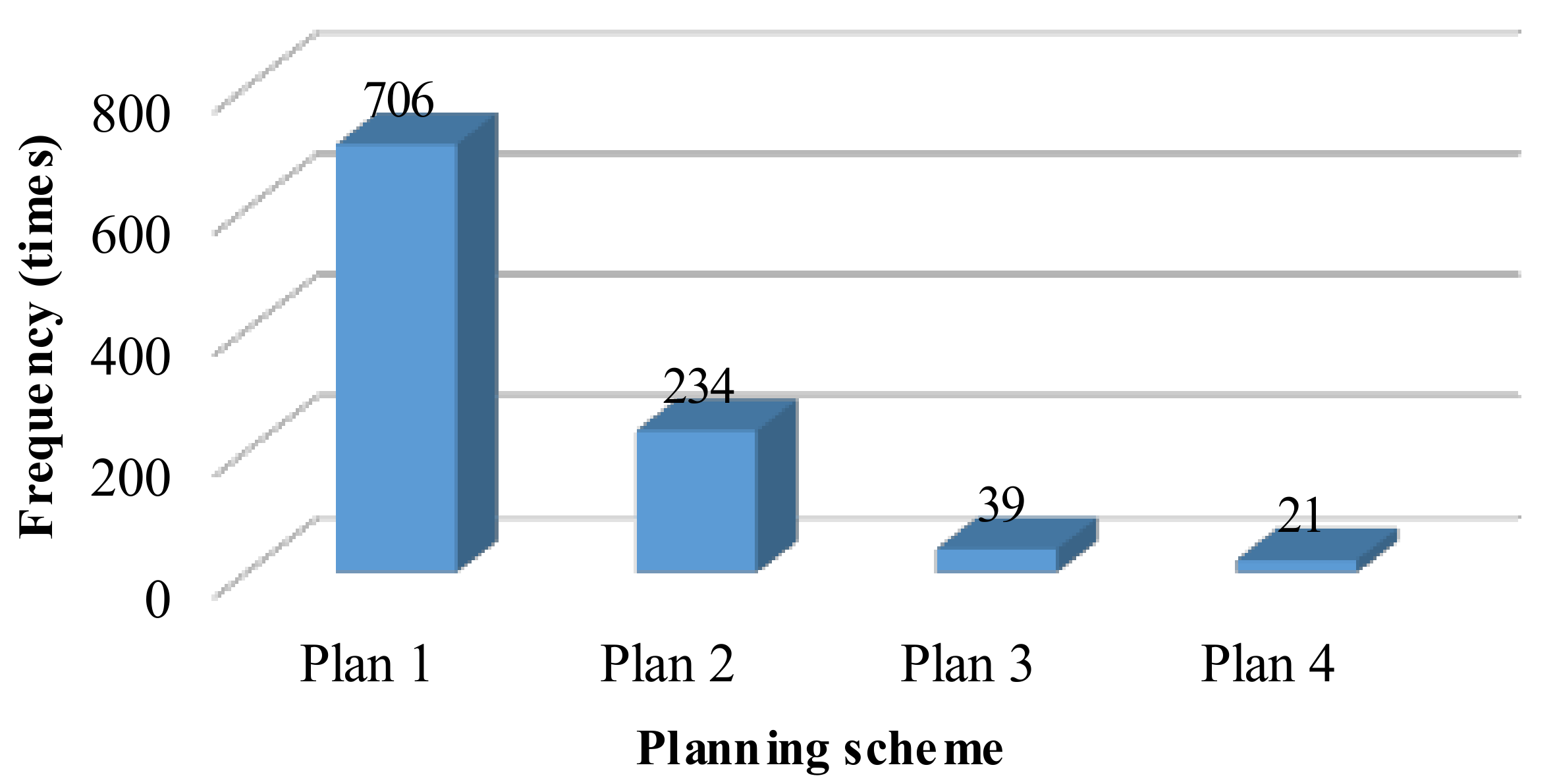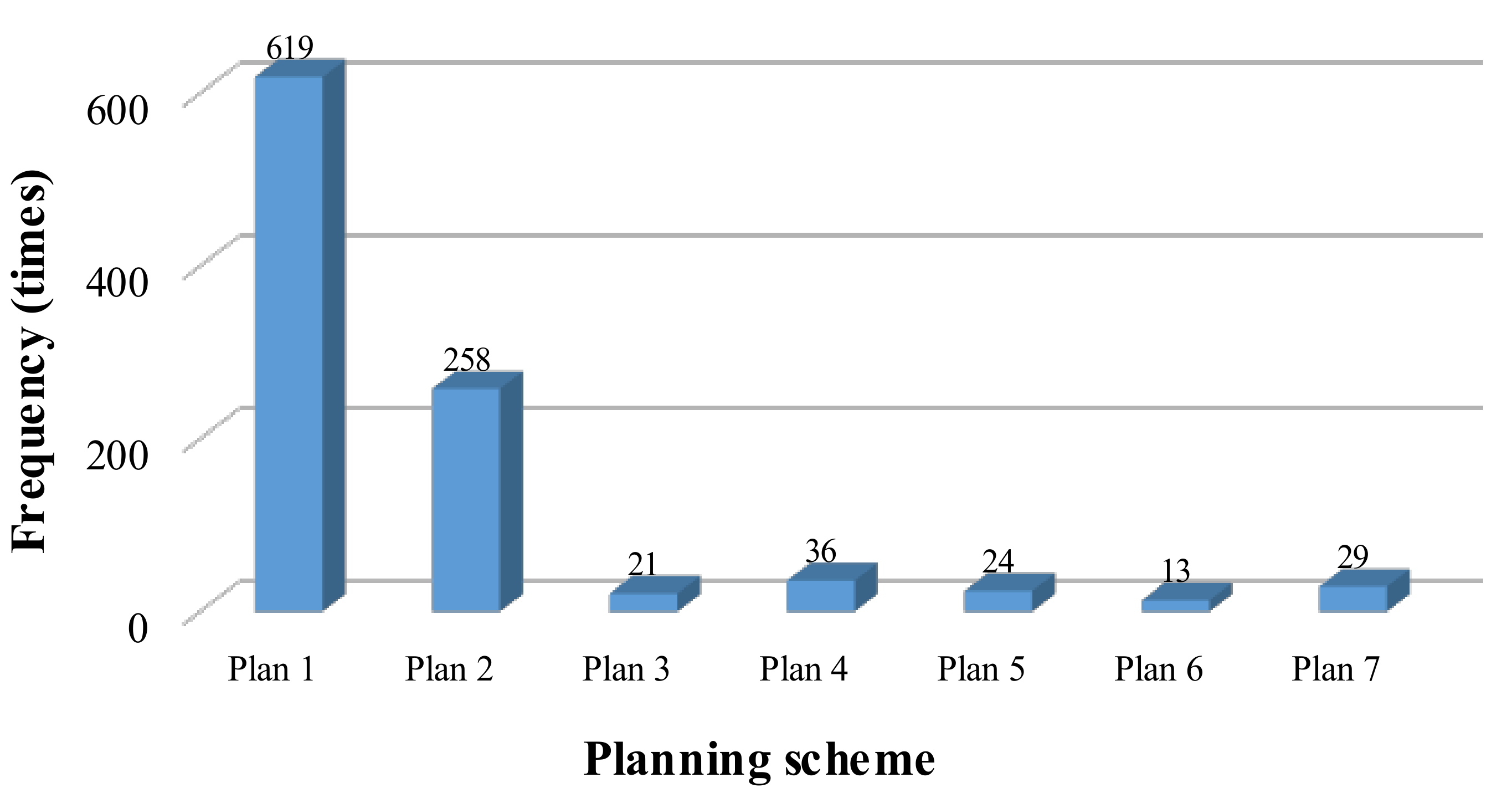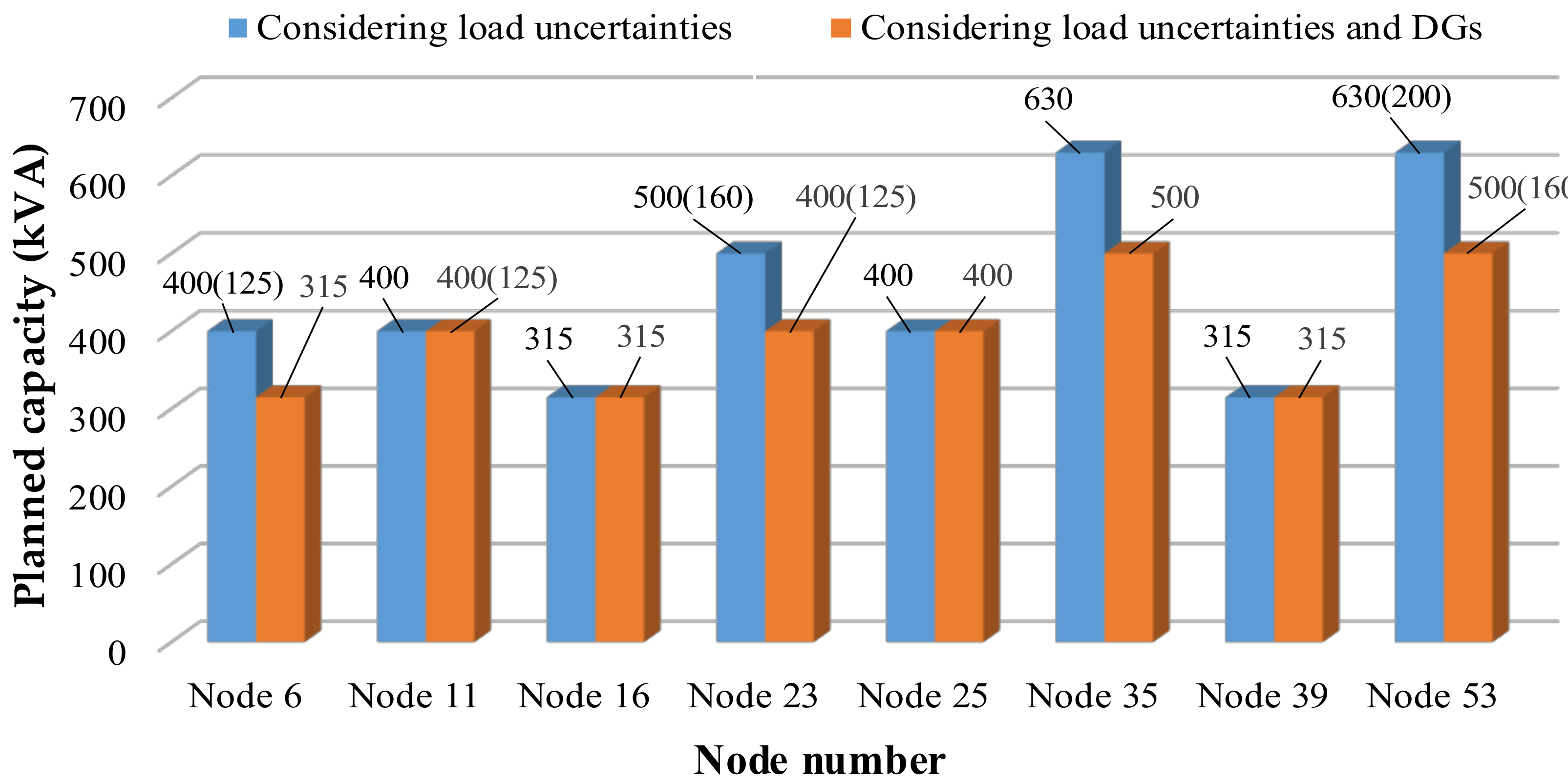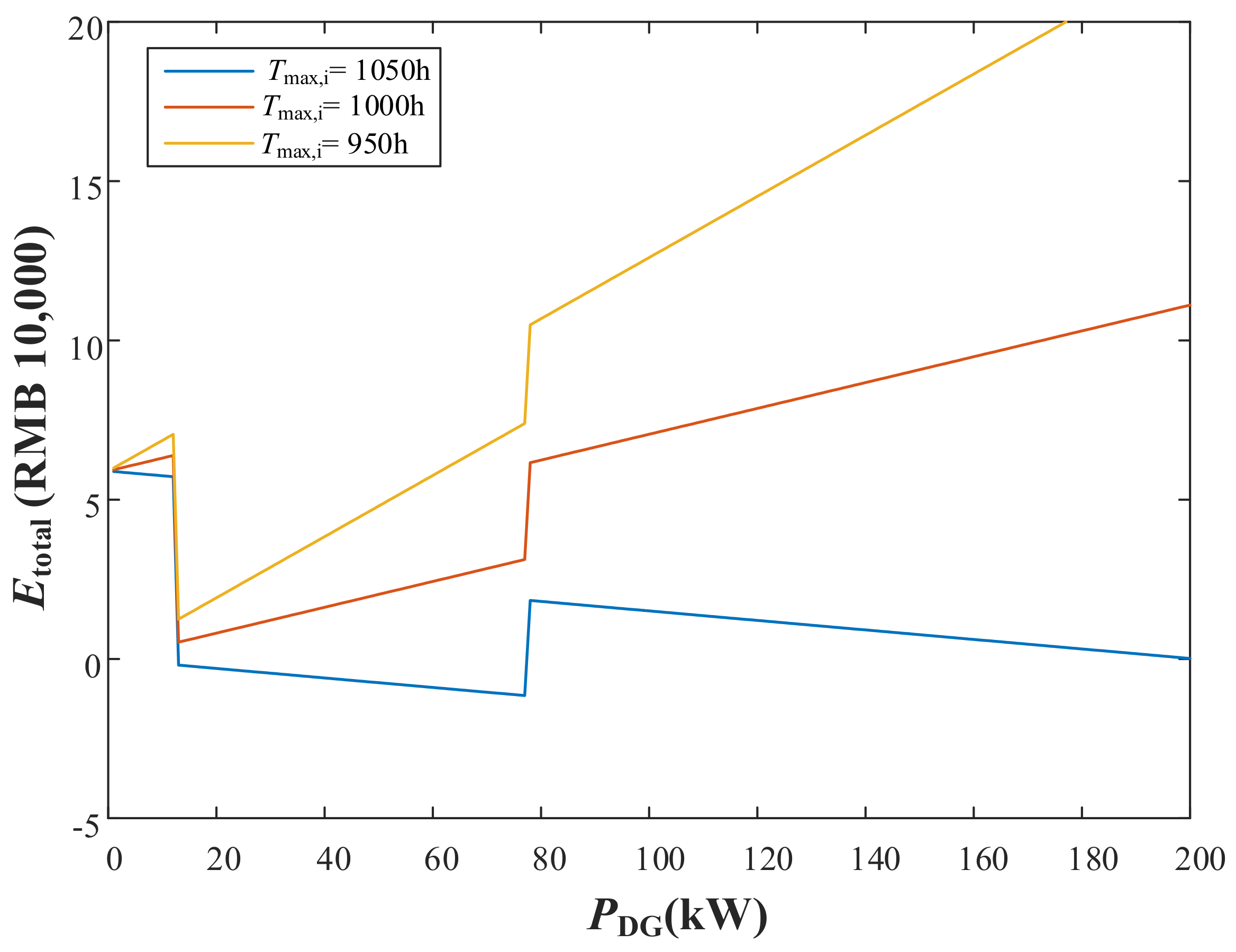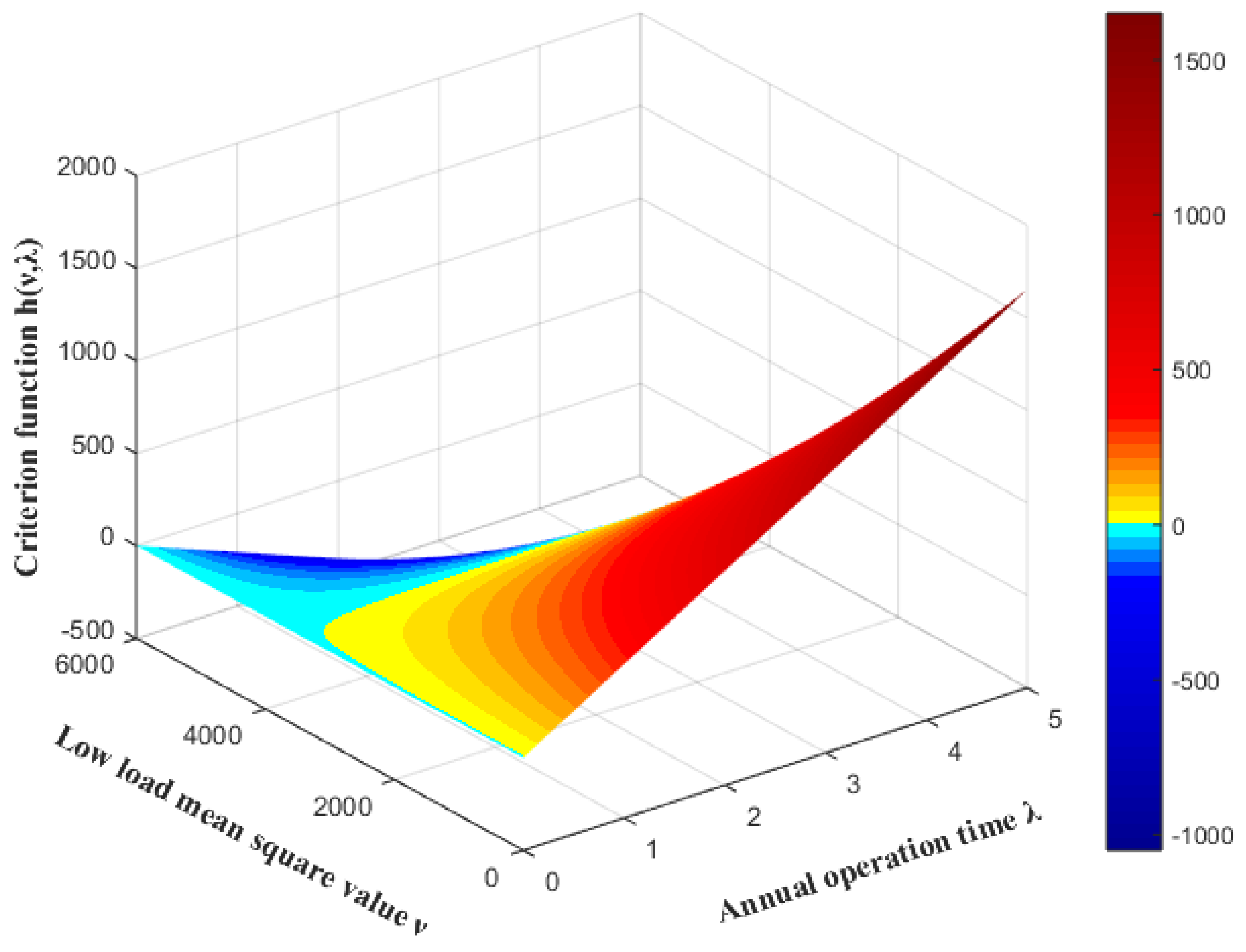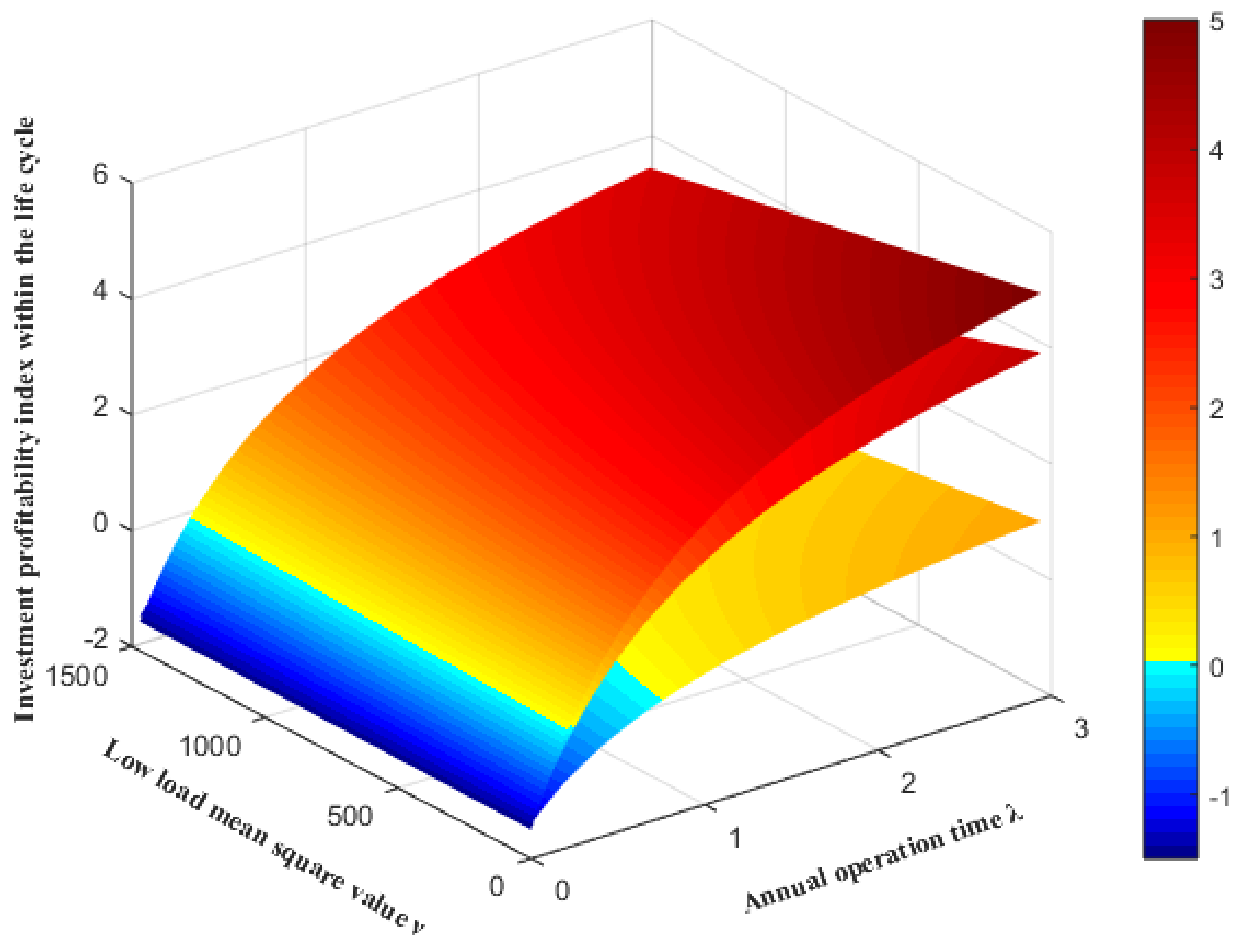1. Introduction
The heavy use of fossil fuels such as oil, coal, and gas in urban distribution networks can lead to haze [
1,
2,
3] and other air pollution, which may cause diseases, allergies and also human deaths. In order to reduce the emission of pollutants like pure carbon dust, carbon dioxide, sulfur dioxide and nitrogen oxide [
4,
5] and construct an urban air environment with green development, replacing oil, coal, and gas with electric energy on the load side, called electric energy replacement, is promoted by the national energy department in China. In recent years, northern residents have gradually used electric heating to replace fire coal; industry has vigorously promoted electric boilers and electric furnaces as power sources of production, electric vehicles and electric buses have been introduced into the transportation field, and in the power supply and consumption field, there are energy storage equipment, port power supply, electric cooking appliances, etc.
Against the background of electric energy replacement, the valley/peak differences of electrical loads in distribution networks continuously increase, significantly increasing the no-load losses of distribution transformers, which is adverse to the economical operation of distribution networks. On-load capacity regulating distribution transformers have two capacities, which has been used to deal with loads with great valley/peak differences in rural areas.
Figure 1a shows actual pictures of an on- load capacity regulating distribution transformer, while
Figure 1b shows the circuit structure, where the red line represents a closed switch. When the on-load capacity regulating distribution transformer is adjusted from high-capacity operation to low-capacity operation, the high-voltage winding is changed from triangle connection to star connection, and the phase voltage reduces to 1/
of the original phase voltage. The parallel part of the low-voltage winding is changed to a series connection, and the winding turns increases to
times the original winding turns. Due to the fact the ratio of voltage reduction is equal to the ratio of winding turns increase, the output voltage is stable, but by the reason that the low-voltage winding turns increases, the magnetic flux density of the iron core is greatly reduced, so as to greatly reduce the no-load loss of the transformer. What’s more, as on-load capacity regulating distribution transformer manufacturing technology gradually becomes mature, it’s possible to popularize on-load capacity regulating distribution transformers at low cost [
6], so transforming conventional distribution transformers into on-load capacity regulating distribution transformers can effectively solve the power loss problems caused by electric energy replacement.
Because the on-load capacity regulating distribution transformer is a new type of energy-saving transformer, there are not many studies on it at this stage. Previous studies proposed an intelligent design scheme [
7] and control strategy [
8] for on-load capacity regulating distribution transformers, verifying that the on-load capacity regulating distribution transformers are appropriate for long-term light-load areas. With the development of power electronic switches, researchers have designed new on-load capacity regulating distribution transformer structures with anti-parallel thyristor valves [
9] and solid state relays [
10] as capacity regulating switches. To plan on-load capacity regulating distribution transformers reasonably, [
11] discussed the impact of the electricity load characteristics on the distribution transformer economic operation, and gives the annual average load rate range for configuration with on-load capacity regulating distribution transformers. Then, for the safety of the power system, the voltage fluctuation of on-load capacity regulating distribution transformers while switching capacity is discussed in [
12], the various faults occurring in on-load capacity regulating distribution transformers are analyzed and effective detection and control technology is put forward in [
13]. Existing studies on on-load capacity regulating distribution transformers are mainly specific to rural distribution networks, and no literatures have studied planning methods for on-load capacity regulating distribution transformers in urban distribution networks after electric energy replacement. Compared with rural distribution networks, the load characteristics of urban distribution networks after electric energy replacement are different. Therefore, studying a planning method of on-load capacity regulating distribution transformers in an urban distribution network after electric energy replacement is of great theoretical and practical significance to the upgrading and reconstruction of distribution transformers after electric energy replacement.
Distribution transformer upgrading and reconstruction was combined with electric energy replacement to study optimal planning method of on-load capacity regulating distribution transformers in an urban distribution network in this paper. Firstly, the nodal effective load considering uncertainties within the life cycle after electric energy replacement was obtained by a Monte Carlo method. Secondly, a replacement criterion for on-load capacity regulating distribution transformers was proposed according to the loss relation between on-load capacity regulating distribution transformers and conventional distribution transformers, and a set of distribution transformer replaceable points considering electric energy loss was obtained. Then a planning model of on-load capacity regulating distribution transformers was established according to a cost benefit analysis of the replacement with on-load capacity regulating distribution transformers. Based on the distribution transformer replaceable point set, a branch and bound method was used to obtain a planning scheme of on-load capacity regulating distribution transformers in urban distribution networks after electric energy replacement, and this provide a theoretical basis for upgrading and reconstruction of distribution transformers matching electric energy replacement needs.
3. Replacing Criterion for On-Load Capacity Regulating Distribution Transformers
Distribution transformer planning after electric energy replacement needs to determine the replaceable points for on-load capacity regulating distribution transformers. In order to get the replacement criterion, an active loss analysis of a conventional distribution transformer and an on-load capacity regulating distribution transformer is carried out as follows.
The active loss of a distribution transformer consists of no-load losses caused by excitation conductance and load losses caused by the winding resistance and it’s the main part of the losses in the distribution network. For a conventional distribution transformer, the active loss
can be calculated according to the following equation:
where SN is rated capacity of distribution transformer, P0 and Pk are the no-load loss and short-circuit loss of the distribution transformer and S(t) is the apparent power of the distribution transformer load.
An on-load capacity regulating distribution transformer has two capacities and can automatically switch capacity through an on-load capacity regulating switch according to the actual load. Then the active loss
of an on-load capacity regulating distribution transformer is obtained as follows:
where
SNH and
SNL are the large and small rated capacities of the on-load capacity regulating distribution transformer;
Sc is the critical capacity regulating load of the on-load capacity regulating distribution transformer, and its value is acquired through theoretical calculation [
8].
P0H and
P0L are the no-load losses of the on-load capacity regulating distribution transformer under large-capacity and small-capacity operations, respectively, and
PkH and
PkL are the short-circuit losses under large-capacity and small-capacity operations of the on-load capacity regulating distribution transformer, respectively.
In order to compare the loss characteristics of an on-load capacity regulating distribution transformer and a conventional distribution transformer, saved active loss ∆
Ploss(
t) and annual saved active loss ∆
Ploss after a conventional distribution transformer is replaced by an on-load capacity regulating distribution transformer are obtained according to (12) and (13) as follows:
where
tH is the annual operation time of an on-load capacity regulating distribution transformer under large-capacity operation,
tL is the annual operation time of an on-load capacity regulating distribution transformer under small-capacity operation,
τ is equal to 1 h,
SH(
t) and
SL(
t) are the apparent powers of the on-load capacity regulating distribution transformer under large-capacity and small-capacity operations, and their values are determined according to the following equation:
When the annual active loss of on-load capacity regulating distribution transformer is lower than that of the conventional distribution transformer, i.e., the annual saved active loss is greater than 0, an on-load capacity regulating distribution transformer is used to replace the conventional distribution transformer. From (15) the annual saved active loss is related to the annual electrical load, so whether to replace a conventional distribution transformer with an on-load capacity regulating distribution transformer is decided by the annual electrical load characteristics. In order to characterize the annual electrical load, three characteristic indexes—high load mean square value μ, low load mean square value ν and annual operation time ratio λ of annual continuous apparent power curves—were put forward in this paper.
(1) High load mean square value μ
The load higher than the critical capacity regulating load of an on-load capacity regulating distribution transformer is called high load, and an on-load capacity regulating distribution transformer operates in large-capacity status under high load. In order to measure the load level of an on-load capacity regulating distribution transformer in large-capacity operation, the high load mean square value is defined as follow according to the annual continuous apparent power curve:
where
f(
t) is the annual continuous apparent power curve function and
f−1(
t) is the inverse function of
f(
t). In the annual continuous apparent power curve, the aggregated duration of load greater than
Sc is the large-capacity operation time
tH, so
tH can be changed to
f−1(
Sc) to reduce the number of variables.
(2) Low load mean square value ν
The load lower than the critical capacity regulating load of an on-load capacity regulating distribution transformer is called low load, and an on-load capacity regulating distribution transformer operates in small-capacity status under low load. The low load operation time is equal to the time obtained by reducing the high load operation time from the annual electrification time of the distribution transformer, so a low load mean square value is obtained as:
where
tM is the annual electrification time of the distribution transformer,
Smin is the minimum apparent power. Similarly, the aggregated duration of load greater than
Smin is the annual electrification time
tM, so
tM can be changed to
f−1(
Smin) to reduce the number of variables.
(3) Annual operation time ratio λ
Annual operation time ratio represents the high/low load operation time difference, and it’s decided by the annual continuous apparent power curve and critical capacity regulating load of the on-load capacity regulating distribution transformer:
Then, based on high load mean square value
μ, low load mean square value
ν and annual operation time ratio
λ, the replacement criterion for on-load capacity regulating distribution transformers is obtained according to (15):
where
k1,
k2,
k3 and
k4 are the loss difference coefficients between a conventional distribution transformer and an on-load capacity regulating distribution transformer. It’s noteworthy that this criterion is a necessary but not sufficient condition for replacing conventional distribution transformers with on-load capacity regulating distribution transformers, i.e., the cost benefit of on-load capacity regulating distribution transformer replacement should be further considered to decide whether to replace the distribution transformers.
Therefore, according to the three characteristic indexes of annual continuous apparent power curve and replacement criterion for on-load capacity regulating distribution transformers, the distribution transformer replaceable points can be obtained, then a cost benefit analysis is needed to determine whether the replaceable points are configured with on-load capacity regulating distribution transformers.
4. Planning Method of on-Load Capacity Regulating Distribution Transformers in Urban Distribution Network after Electric energy Replacement
4.1. Cost Benefit Analysis of Replacing with on-Load Capacity Regulating Distribution Transformer
An on-load capacity regulating distribution transformer needs more investment while a conventional distribution transformer has more active losses. In order to measure the cost benefit of replacing a conventional distribution transformer with an on-load capacity regulating distribution transformer, three cost benefit indexes—investment profitability index FE within the life cycle, investment cost recouping index FT and capacity regulating cost index FC—are proposed.
(1) Investment profitability index FE within the life cycle
An on-load capacity regulating distribution transformer has a higher acquisition price and operations & maintenance cost and lower active losses when compared with a conventional distribution transformer [
20]. Therefore, in order to characterize the economic benefit created by replacing a conventional distribution transformer with an on-load capacity regulating distribution transformer during the life cycle, the investment profitability index
FE within the life cycle is proposed in this paper as:
where the subscript
i represents the parameter in the
i(th) year.
χprice is the price of an on-load capacity regulating distribution transformer. When the capacity of a distribution transformer is not enough for the load,
θprice is the price of a planned conventional distribution transformer, when the capacity is enough,
θprice is 0.
ϕprice is the hourly electric charge and
CM is the increment of operations & maintenance cost after a conventional distribution transformer is replaced by an on-load capacity regulating distribution transformer. As faults of on-load capacity regulating distribution transformers not only include all faults of conventional distribution transformers but also include faults of the on-load capacity regulating switch, the increment
CM of operations & maintenance cost is the sum of the operations & maintenance cost of an on-load capacity regulating switch within the life cycle and the life of distribution transformer is set as 20 years in this paper:
where
Ccap is the average annual operations & maintenance cost of an on-load capacity regulating switch.
(2) Investment cost recouping index FT
Reconstruction investment is needed when conventional distribution transformers are replaced by on-load capacity regulating distribution transformers. The investment cost includes the acquisition cost and operations & maintenance cost of distribution transformers. When the on-load capacity regulating distribution transformer is put into operation, electric charge savings brought by the reduction of active losses will be taken as the means of recouping the reconstruction investment cost, but the reconstruction funds of distribution networks are limited and in consideration of the investment payback period of the reconstruction fund, the cost-recovery time is taken as the investment cost recouping index
FT for evaluating replacement with on-load capacity regulating distribution transformers:
(3) Capacity regulating cost index FC
The on-load capacity regulating switch is an important constituent part of an on-load capacity regulating distribution transformer, and its service life is related to the switching times of the transformer capacity, i.e., the greater the transformer capacity switching times, the more easily the on-load capacity regulating switch will suffer from a fault, so the load’s requirement for switching times of an on-load capacity regulating switch is incorporated into the cost benefit analysis of replacing with on-load capacity regulating distribution transformers, and capacity regulating cost index
FC is defined as follows:
where
NT,t is the operating state of an on-load capacity regulating distribution transformer,
NT,t = 1 expresses that it operates in large-capacity status while
NT,t = 0 means that it operates in small-capacity status;
Rprice is the price of an on-load capacity regulating switch;
n is the maximum switching times of the on-load capacity regulating switch.
4.2. Planning Model of on-Load Capacity Regulating Distribution Transformers in Urban Distribution Network after Electric Energy Replacement
Distribution transformer upgrading and reconstruction which matches electric energy replacements includes the capacity expansion of conventional distribution transformers and their replacement with on-load capacity regulating distribution transformers: (1) capacity expansion of conventional distribution transformers refers to the fact that original distribution transformer capacity must be expanded when it can’t satisfy the load after electric energy replacement, and it can be directly replaced by large-capacity on-load capacity regulating distribution transformers, or large-capacity conventional distribution transformers for capacity expansion; (2) replacement with on-load capacity regulating distribution transformers means that when the present distribution transformer capacity is enough, it should be replaced by on-load capacity regulating distribution transformers to save electric energy losses in consideration that the loss of present distribution transformers is great.
In reality, distribution transformer upgrading and reconstruction funds which match electric energy replacement are usually limited, and replacement can’t be implemented for all distribution transformer replaceable points. On the condition that only one distribution transformer is accessed at each electric energy replacement point, a distribution transformer replaceable point set Ω is obtained according to the replacement criterion for on-load capacity regulating distribution transformers as shown in (20), and the replaceable points in set Ω are taken as optimization variables to construct an on-load capacity regulating distribution transformer planning model in urban distribution networks. The optimization variable
xj is the state about whether a conventional distribution transformer in position
j is replaced by an on-load capacity regulating distribution transformer. If it’s equal to 1, it means that the conventional distribution transformer is replaced by an on-load capacity regulating distribution transformer; and if it’s equal to 0, it means no replacement, and then:
From the cost benefit analysis of replacement with an on-load capacity regulating distribution transformer in
Section 4.1, it can be known that the optimal planning scheme of distribution transformers needs to realize the maximum investment profitability index
FE within the life cycle as well as the minimum investment cost recouping index
FT and capacity regulating cost index
FC. A multi-objective optimization [
21,
22] approach is used to establish the planning model of on-load capacity regulating distribution transformers in urban distribution networks after electric energy replacement. Therefore, a normalized weighing of the above indexes is implemented to obtain a comprehensive benefit index
F which is taken as objective function of the planning model:
where
wE,
wT and
wC are the weighing coefficients of the three cost benefit indexes, respectively, and they are constants within 0~1. The pecking-order comparison method is used to determine the weighing coefficients
wE,
wT and
wC, according to the importance of the three cost benefit indexes.
Xij (
i = 1, 2, 3;
j = 1, 2, 3;
i ≠
j), satisfying (27), is used to measure the importance of index
i relative to index
j. The larger the number is, the greater the importance is. After comparison, the values in one row are summed up, and the final weight is calculated by dividing the total value of row by the total sum, shown in
Table 1. Then
wE,
wT and
wC are successively equal to the weight from up to bottom:
Moreover, distribution transformer upgrading and reconstruction which matches electric energy replacement needs to satisfy the overall investment constraint, so the total sum of the capacity expansion cost of conventional distribution transformers, acquisition cost of on-load capacity regulating distribution transformers and incremental operations & maintenance cost within the life cycle should be smaller than the total investment
E of distribution transformers:
where subscript
j represents the parameter corresponding to position
j, and capacity upgrading set Φ is the set of the distribution transformers that can’t satisfy the load after electric energy replacement. To sum up, the planning model of on-load capacity regulating distribution transformer in urban distribution network after electric energy replacement is as follows:
4.3. Calculation Procedure of on-Load Capacity Regulating Distribution Transformer Planning in Urban Distribution Network after Electric Energy Replacement
According to the replacement criterion for on-load capacity regulating distribution transformers and its planning model, the calculation procedure of on-load capacity regulating distribution transformer planning in an urban distribution network after electric energy replacement is obtained as follows:
Step 1: A Monte Carlo method is used to randomly sample the apparent power of loads, output power of wind power and photovoltaic so as to obtain annual apparent power curves of the nodal effective load considering uncertainties within 20 years after electric energy replacement.
Step 2: In line with the annual apparent power curve in the first year of electric energy replacement, and the principle of distribution transformer rated capacity being greater than and closest to the maximum load, the planned capacity of distribution transformers is selected for electric energy replacement points. Then three characteristic indexes of annual continuous apparent power curve are calculated, and replaceable point set Ω and capacity upgrading set Φ are obtained.
Step 3: On the basis of the apparent power curves within 20 years after electric energy replacement, three cost benefit indexes of replacement with on-load capacity regulating distribution transformers at replaceable points are calculated, namely investment profitability index FE within the life cycle, investment cost recouping index FT and capacity regulating cost index FC.
Step 4: The branch and bound method [
23] in an 0–1 integer programming method is used to solve the planning model of on-load capacity regulating distribution transformers in urban distribution networkz to obtain the planning scheme of on-load capacity regulating distribution transformers.
Step 5: Step 1 to step 4 are repeated to get the results of N group Monte Carlo experiments, and the most frequent planning scheme is the optimal planning scheme of on-load capacity regulating distribution transformers.
